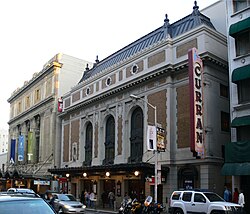Curran Theatre
 |
|
| Address | 445 Geary San Francisco United States |
|---|---|
| Coordinates | 37°47′13″N 122°24′38″W / 37.786972°N 122.410631°W |
| Owner | Carole Shorenstein Hays |
| Type | Broadway |
| Capacity | 1,667 |
| Opened | 1922 |
The Curran Theatre is located in San Francisco and was named by its first owner, Homer Curran. As of 2014, the theater is owned by Carole Shorenstein Hays.
Curran operated another theater with his name for several years prior to building this Curran Theatre; however, the original Curran Theatre had various names before and after this time, whereas this Curran Theatre has never had another name. It opened in February 1922 and was initially considered a Shubert house. Later, it was a showcase for Theatre Guild presentations. Subsequently, it became closely associated with the Civic Light Opera (CLO), which also operated in Los Angeles. The CLO obtained numerous prestigious bookings as well as produced their own shows (often with star names as the leads).
Curran wrote the book for the musical Song of Norway and co-wrote the book for Magdalena. He eventually left San Francisco for southern California, where he rented theatrical lighting.
The ceiling above the main lobby was hand-painted to look like wood (steel wool was used to fashion a wood grain effect in the plaster before painting). The main lobby has a marble floor but has long since been covered by carpeting. There are "plugs" built into the lobby floor in which to insert stanchions from which theater ropes were hung to section off the lobby. The loge section was modified prior to Hello, Dolly!'s first booking at the theater. Originally, the loge section was similar to the boxes, with movable chairs in sectioned areas. The box-like loges are still evident by what remains of the metal railings in front of the loge section as well as the decorative plaster when viewed from below. The change was made because it increased the seating capacity by about ten seats in this highly desirable area. The interior main floor lobby no longer exists. Originally, it was changed to a minor degree to accommodate the installation of a sound booth without decreasing the orchestra seating capacity. Eventually, the lobby space was used to install a larger bar area as well as accessible restrooms.
The theater has two front curtains: the decorative green fire curtain in front of a gold curtain. When musicals traditionally utilized each theater's front curtains, the first curtain would be raised five minutes prior to the start of the show. There were two coat check rooms: one off to the south of the main floor interior lobby and the other on the balcony (adjacent to the ladies' restroom). There were also two telephone "booths" on the mezzanine lobby—one on each side of the windows. These booths were actually very small rooms with formal doors. The coat check rooms and telephone booths are now used for storage. The theater also had a central vacuum system. This system is still evident by the connection points on the walls, near the floor. The chandelier was built in San Francisco. A plaque honoring Arthur Mayer is mounted at the entrance to boxes L-M-N. Mayer watched the theater being built, was hired by Curran as part of the theater's opening-night staff, and continued working at the theater until he was nearly 100 years old.
...
Wikipedia
